The Explore Cordoba article will reveal some fascinating sights of this charming historic town in Andalusia.

©
Explore Cordoba: Must-see attractions in Córdoba
First, we’d like to point out that we have put many sights on the list. So if you have just a few hours or a day, put the Mezquita, Juderia, Alcazar, Patios, and a Roman bridge on your to-do list and try some typical local cuisine. However, you will dedicate more than a day to this beautiful city. We recommend visiting the Ruins in Azahara and relaxing at the Andalusian traditional spa resorts.
Mezquita
It’s impossible to evaluate the beauty of Córdoba’s great mosque with its exceptionally tranquil and immense interior. One of the world’s greatest works of Islamic architecture hints, with all its shiny ornamentation, at a cultured age when Muslims, Jews, and Christians lived side by side and enriched their city with a diverse, let’s culture. So, let’s see why is this Majestic Mezquita so important.
That’s why the Mezquita of Cordoba is one of the most unique temples in the world. It was once one of the largest mosques in the Muslim world. Later, in the 16th century, a Christian cathedral was built in the middle of the Arab temple. A visit to the Mezquita will surprise you constantly when you think of the fantastic skills of the artists who made it. Arches, ceilings, walls,…
Note: If you want to learn more about Mezquita, please read our article.
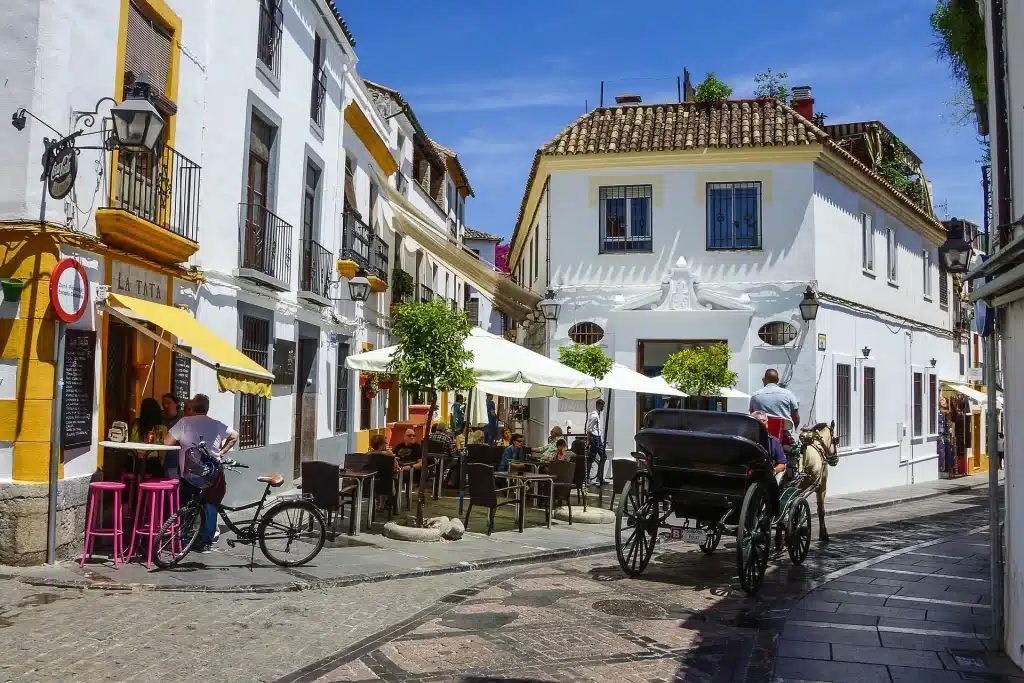
©Frank Nürnberger
Judería
The Judería de Córdoba, the city’s Jewish Quarter, is close to the Mezquita. This area is a labyrinth of narrow streets; houses painted white, and tons of flowerpots!
Don’t worry if you get lost in the streets and squares of Judería (which is not complicated at all). You’ll find places that retain the medieval recollection of the city of three cultures, as the neighborhood has charm and magic.

©
Explore Cordoba’s Patios
Cordoba’s patios are as old as the city itself. First, the Romans built their houses around a central courtyard to escape the heat of Andalusian summers.
Arabs perfected the tradition by turning the courtyards into colorful oases of potted plants, wrought iron gateways, and tileCordoba’sns. Today Cordoba’s courtyards are famous all across Europe. The best time to see them is during the Patio Festival during the first week of May.
Streets of Cordoba Historic Centerpeople’sa sense of people’s lives in Moorish Cordoba wander among the small winding streets of the historic center. Some of the most picturesque streets are Calleja de la Flores (Flower Alley) and Calleja Pañuelo.
Note: Please read our article about the Festival of Patios in Cordoba.
Calleja de la Flores is a flower-studded alleyway with a tiny square Mezquita can see its bell tower from the square framed by the whitewashed walls of residential houses. In Moorish times, the alley would have looked out on the minaret.
Calleja Pañuelo is remarkable for being the narrowest alley in Cordoba. Some say it’s the smallest square in the world. The passage ends at an equally tiny courtyard with a small fountain and a single orange tree.
Palacio de Viana
The Viana Palace is a joy to visit in spring, a dazzling Renaissance palace with 12 beautiful, plant-filled patios. The aristocratic Marqueses de Viana occupied the large building until 1980, packed with art and antiques. You can walk around the lovely patios and garden with a self-guiding leaflet or take a guide. It’s of the rooms. It’s an 800m walk northeast of Plaza de las Tendillas.
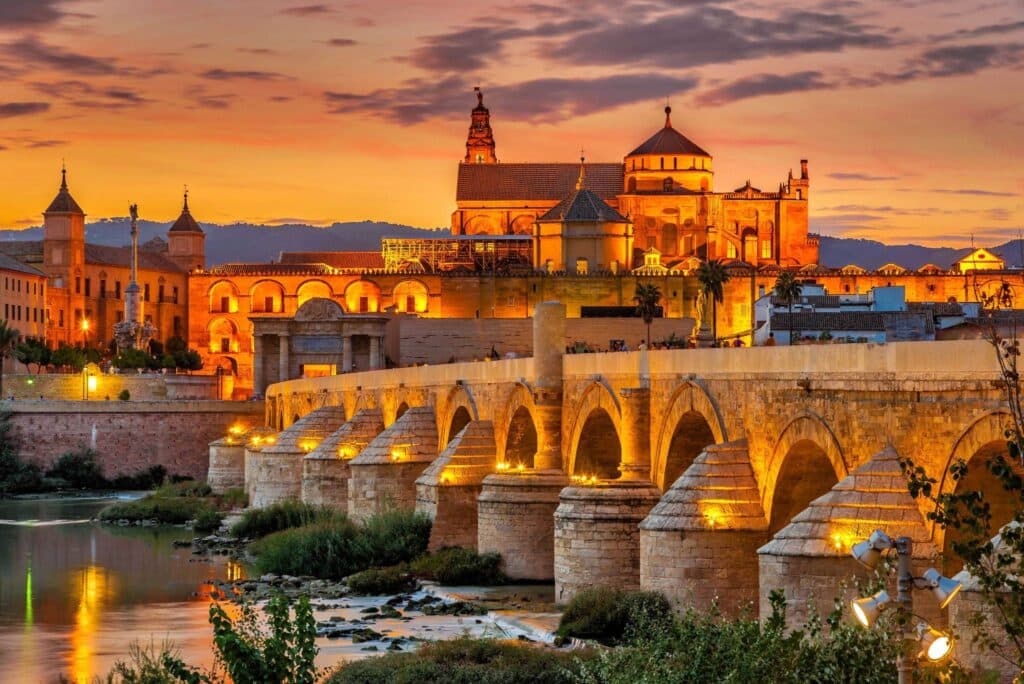
©expansion.com
Puente Romano
Spanning the Río Guadalquivir just below the Mezquita, the pretty, 16-arched Roman bridge formed part of the ancient Via Augusta, which ran from Girona in Catalonia to Cádiz. Rebuilt several times over centuries, it’s now traffic-free and makes for a lovely stroll. With the aid of CGI, it not long ago featured as the Long Bridge of Volantis in Game of Thrones.

©iberian-escapes.com
Hammam Al Andalus
After long wandering, it’s time to experience the Arab culture in the atmospheric Hammam Al-Andalus. After spending an hour wandering between medium, hot, and cold pools, you’ll find sauna rooms. After that, you will feel relaxed and ready for new evening adventures.
Cordoba’s Hammam Al-Andalus near the Mezquita offers a variety of options for a visit, from the standard bathing experience for 34 euros to a decadent package of bathing, a traditional kessa bath, and a relaxing massage for 87 euros.
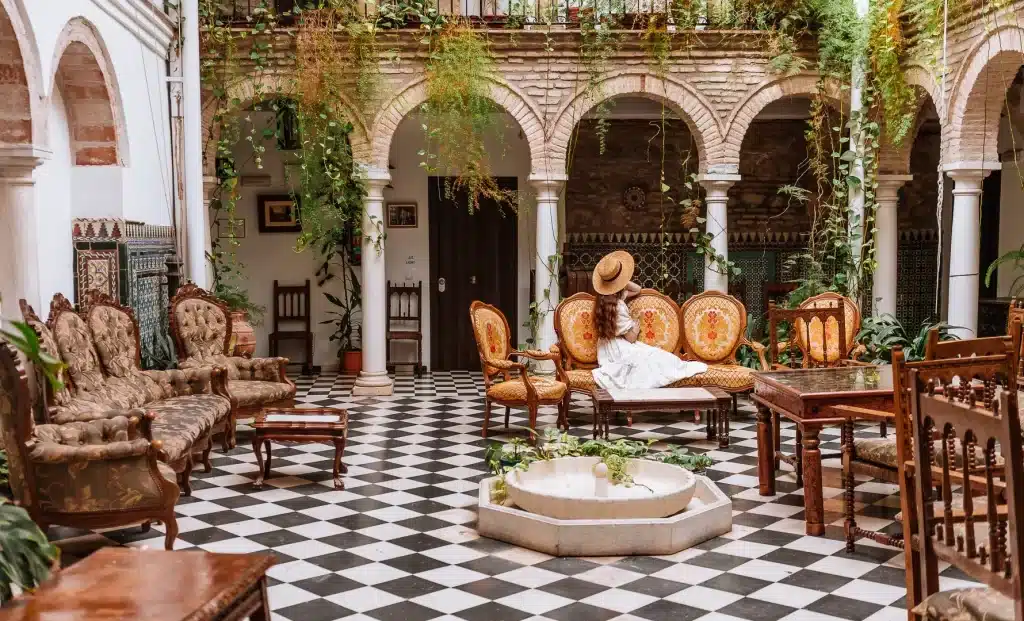
©capturingourdays.com
Moroccan Tea House
Cordoban tea houses or teterias are a must-visit in Cordoba. To have a full Moorish style eCordoba’s, head to Cordoba’s most enchanting Moroccan Tea House – Salon de Té. Located in the Juderia, in a humble 13th-century building at Calle Buen Pastor, 13, Salon de Te is beautiful, featuring delicate North African decor complete with columns and arched entrances, plants climbing up the walls, and gentle mood lighting.
Order a pot of mint tea for a traditional Moorish experience or a full Andalusian breakfast.
Medina Azahara
The next attraction of Moorish city is Medina Azahara, located 7 km outside of Cordoba. It used to be a royal palace constructed in 929 A.D. by the first Caliph of Cordoba, Abd-al Rahman III. The rumor is that the castle was dedicated to the Caliph’s favorite, Azahara.
It is almost unbelievable to think that such a city, built over 35 years, would last only a few more before the usurper Al-Mansur transferred the government to a new palace complex of his own in 981. Then, between 1010 and 1013, Medina Azahara was wrecked by Berber soldiers. During succeeding centuries, its ruins were plundered repeatedly for building materials.
You can visit the site alone. However, the buses are irregular, so we recommend visiting Medina Azahara on an organized tour.
Baños del Alcázar Califal
The bathhouse of the 10th-century caliphs, part of the Moorish Alcázar complex that the Alcázar de los Reyes Cristianos later replaced, is the most remarkable of the few Arab bathhouses that survive from the 600 that Moorish Córdoba boasted. With the typical arrangement of cold, warm, and hot rooms, the now-underground complex has been partly restored to its original appearance with horseshoe arches, elegant pillars, and star-shaped skylights.

©pointsearch.com
Casa Andalusí
The Casa Andalusí is a restored 12th-century house that attempts to recreate an ambiance of caliphal times. It has a tinkling fountain on the patio and various exhibits, Córdoba’s mainly to Córdoba’s medieval Muslim culture, a Roman mosaic in the basement, and a shop selling North African items.
Cordoba Synagogue
Located in the Jewish Quarter, it’s the only existing synagogue in Andalusia and the third best preserved in Spaiit’slthough small, it’s worth a visit, especially for the lovely stucco decorations of the main hall.
Until the expulsion of the Jews, Cordoba Synagogue served as a temple. Later, it was used as a hospital and school before being recognized as a national monument in the 19th century.
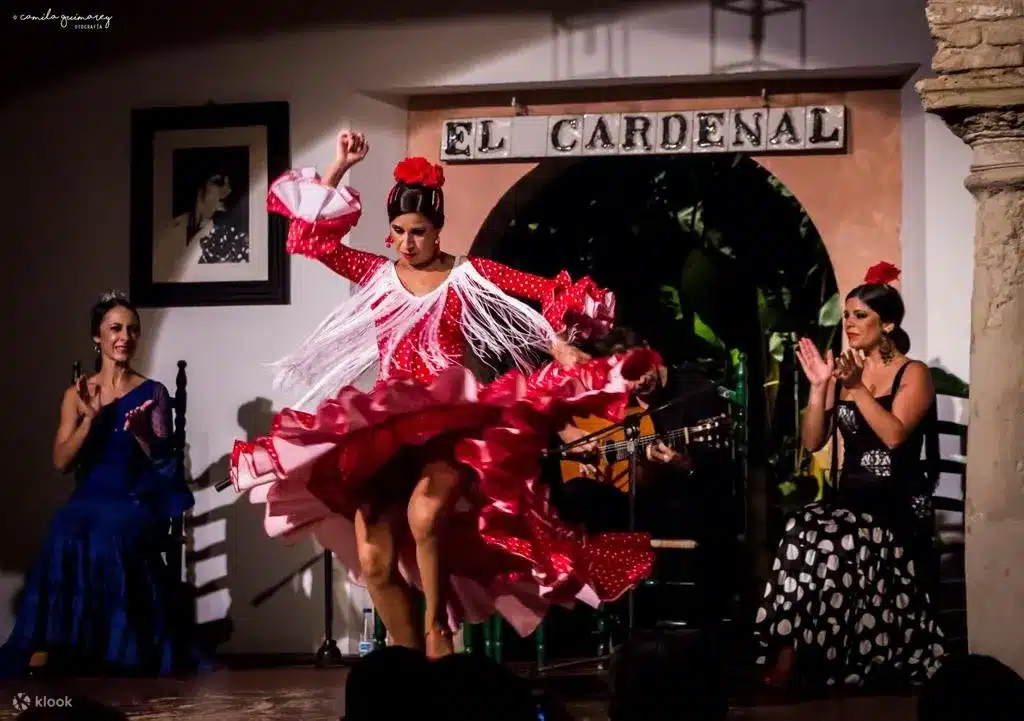
©.klook.com
Enjoy the Flamenco show in Cordoba
Flamenco culture is strong across the Andalusian region, but it is particularly emphasized in Cordoba. The city is one of the best places to enjoy a flamenco show. As you travel between the main areas in Cordoba, you will realize that residents are experts in the lost art of truly enjoying life.
Centro Flamenco Fosforito
Possibly the best flamenco museum in Andalucía, the Fosforito Center has exhibits, film, and information panels in English and Spanish telling you the history of the guitar and all the flamenco greats.
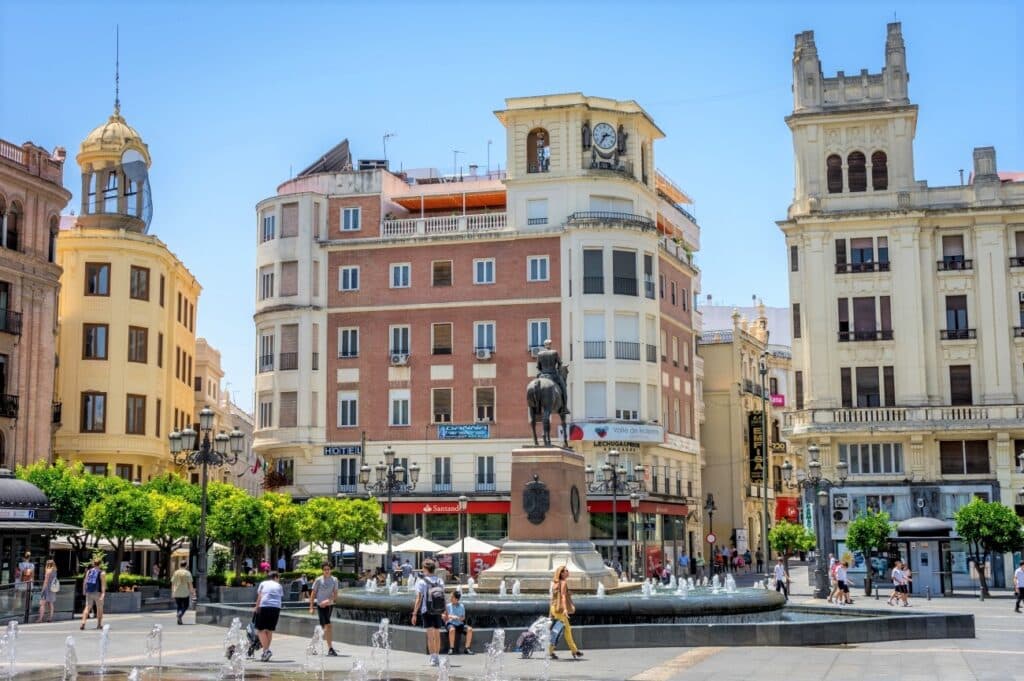
©iberian-escapes.com
Plaza De Las Tendillas
The next thing to do is walk around the Plaza de las Tendillas, the city’s shopping district. Here you’ll find a series of cafes and restaurants with outdoor terraces. On the way there, you can pick up a souvenir in shops like Olive & Co, which sells beauty products made with local olive oil, or the Faustino Prieto for delicious cured meats. The square is even more special at night when the fountains light up.

©iberian-escapes.com
Plaza De La Corredera
After you say all the main attractions, you can slowly go to Plaza de la Corredera for an afternoon drink. Built in the 1600s, it’s one of the city’s famous squares. The Plaza features a classic Castilian style, rectangular shape, and surrounding arcades. It’s been used for numerous purposes, including executions, bullfights, and food markets. However, these days it’s a meeting point for locals and tourists, who gather around its terraces.
Caballerizas Reales
These elegant stables were built on orders of King Felipe II in 1570 as a center for developing the tall Spanish thoroughbred warhorse (caballo andaluz). The center still breeds these fine horses (47 are here today) and trains horses and riders in equestrian disciplines. You can watch training during the daily opening times from Tuesday to Sunday (from 11 am) or attend the one-hour show that impressively combines horse and rider skills with flamenco dance and music.

©makespain.com
Callahora tower
Located on the other side of the bridge, opposite the Mezquita, Calahorra Tower is the oldest defense building in Cordoba. The Moors built it but were later expanded by Christian kings who added a third tower to the structure, giving it a fortress-like appearance.
The main draw of Calahorra is the fantastic view of Mezquita, the bridge, and the old town. There is also an ethnographic museum in the tower – Al-Andalus living museum.
Zoco Municipal souk
Shop for handicrafts at Zoco Municipal. Cordoba’s Souk is a crafts shopping experience with a difference. It is not only Spain’s first craft market; you can also observe the artisans as they create the crafts. The Souk is a series of artisans’ workshops where you can buy their skills.
Zoco souk specialties include silverware, jewelry, leather, wooden puppets, and some of the finest filigree in Cordoba. Filigree is the art of fine silverwork that creates shapes of fine metal wire with tiny beads, and twisted threads soldered together to create exquisite designs.
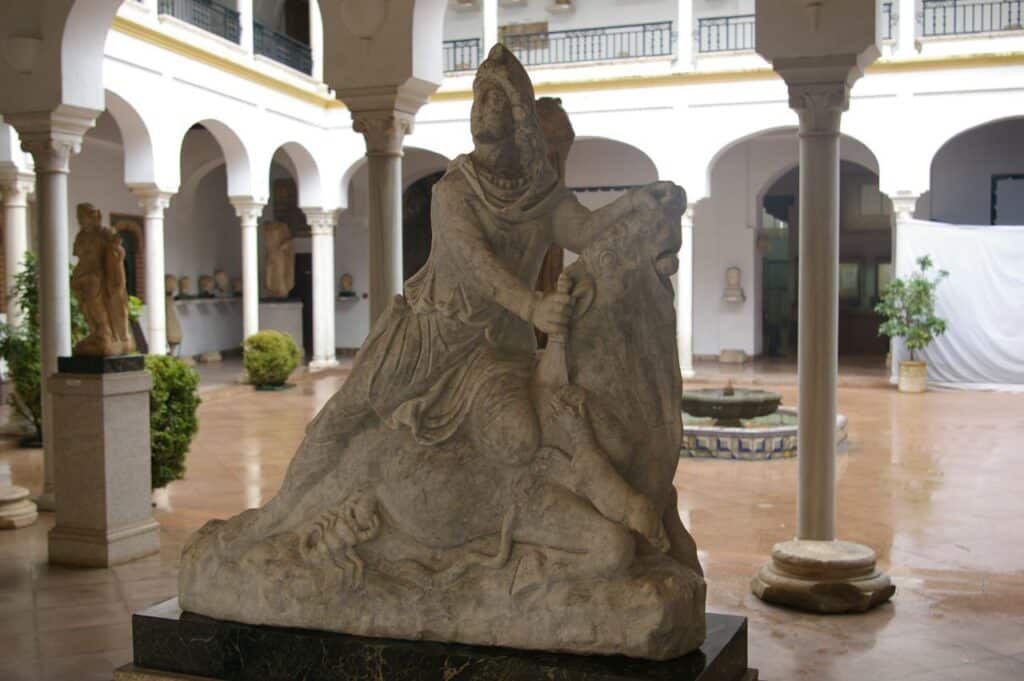
©hotelcaireles.com
Visit Archaeological museum
For history buffs, the Archaeological Museum is a real gem. Sprawled over two buildings, including a former Renaissance-style palace and three courtyards, the Archaeological Museum of Cordoba is one of the finest archaeological museums in Spain.
The eight rooms in the original (palace) building house impressive artifacts from the al-Andalus era. At the same time, the new building features an excCordoba’sexhibit – Cordoba’s Roman Theater.
The most curious fact about the Theater is that for decades, historians and archaeologists were puzzled over its location until the excavations for the new building of the Archaeological Museum began. The Theatre was discovered underneath the building site.
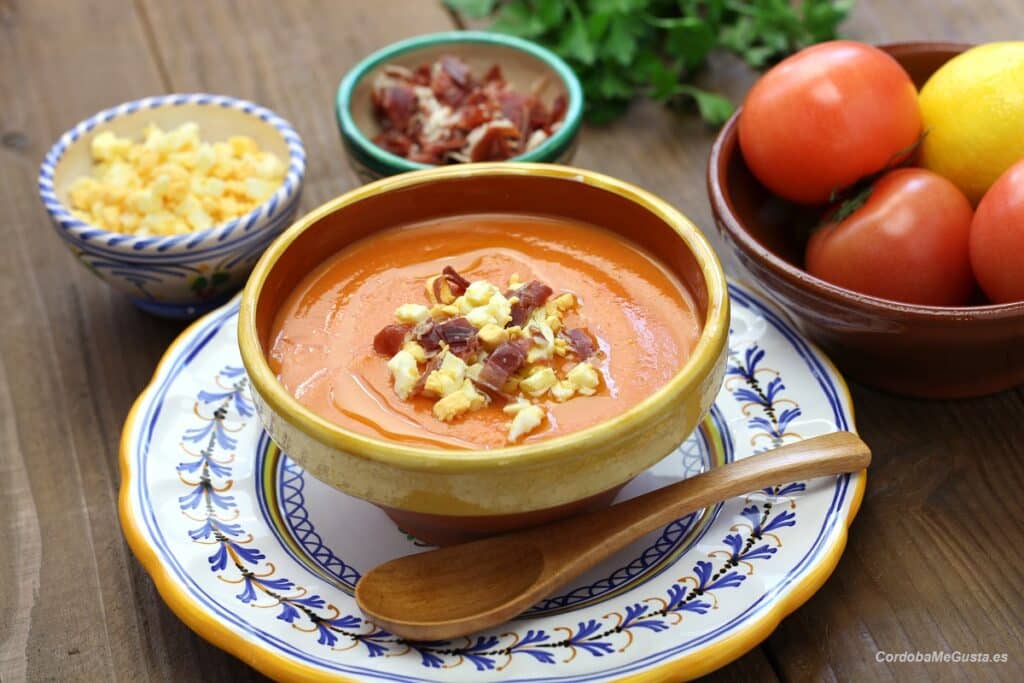
©cordobamegusta.es
Cordoba’ salmorejo: Cordoba’s typical dish.
Córdoba is a burgeoning gastronomic destination, and you’ll find some lovely spots to eat. So, please don’t leave it without tasting its typical salmorejo dish. It is a cold soup (similar to gazpacho) made of tomato, olive oil, bread crumbs, garlic, and vinegar, on which they put small pieces of Serrano ham and eggs.
And to finish with a sweet touch, why not give an ice cream a go?
What is the best time to Explore Cordoba?
Spring is the best time to visit Cordoba. The weather is beautiful, with daytime temperatures around 20-25°C – perfect for walking around the old city center and relaxing in the courtyards of tapas bars.
Cordoba hosts some of the most famous festivals in spring, including Fiera de Los Patios or Patios Festival – the only two weeks in the year when the citizens of Cordoba open the doors of their houses to the public to show off ‘their ‘works of art’ courtyards decorated with plants, water features, and mosaics.
How to get there?
The nearest airports with international connections are Madrid (395 km), Sevilla (140km), Jerez, and Malaga (170 km). Furthermore, there are excellent train connections with Madrid and Seville. Therefore we recommend using this means of transport, even if you visit the city for a day.
Note: Click here to find valuable deals (flights).
Note: Click here to find valuable deals (trains and buses).
Overall, exploring Andalusia by car is the most convenient option. However, your plans are more ambitious, and you’d like to explore Cordoba’s surroundings. In that case, we recommend getting there by car.
How to Explore Cordoba
On Foot
Cordoba is a surprisingly compact city, and the only means of transportation to complete your itinerary are your own feet!
Suppose you will spend a night in Cordoba, depending on your hotel’s location. In that case, you might need to resort to other means of transportation to join the starting point of the itinerary and get back to your hotel after you complete it. We advise booking a hotel in the Cordoba’s center (or at least near).
Bus
Cordoba buses are run by the city’s local authorities and operated by Aucorsa, a municipal company.
There is a network with 15 lines. The buses are relatively new and have air conditioning (essential in summer). As a rule, buses run between 6:00 and 23:30, but it is good to check the times of the line of your interest.
By Car
Although parking prices vary, generally speaking, you can expect to pay around 15 to 20 € per day for parking downtown. One parking lot is near the Roman bridge, on the other side of the Guadalquivir River, just opposite the historic center. However, it can be packed in the peak season.
Where to stay in Cordoba?
If you are considering where to stay in Cordoba, the first thing you should know is that this is not a very large city; all the prettiest areas in Cordoba are not far from each other, and you will be able to visit all of them in just a few days.
So, booking an apartment/room just outside the city center, or at least in Plaza Tendillas or Vial Norte, is best if you need a parking space. From there, you can freely take only a few minute-long walks to the center.
Note: Click here to find valuable deals (accommodation).
FAQs about Cordoba.
Is one day in Cordoba enough?
1 Day in Cordoba is enough to visit the city’s main attractions and areas like the Mosque-Cathedral of Cordoba and the Jewish Quarter. However, if you want to explore beyond its historic center, you’ll need at least two days.
Is Cordoba expensive?
No, Cordoba is one of the cheapest places to visit in Andalucia. You can find affordable accommodation and restaurants across the city.
The conclusion of the Explore Cordoba article
Is the city worth visiting? Yes! Cordoba is a unique and tranquil Andalusian destination, perfect for anyone who loves history, architecture, and food.
Although you can explore the main attractions in Cordoba in one day, we recommend staying at least a weekend to enjoy at a slower pace and even make a day trip to one of the beautiful towns near Cordoba, like Baena and Montilla.
If you have any questions about visiting Cordoba or Southern Spain, leave a comment or email. We’ll be happy to assist you.
Our website includes affiliate links. So, keep in mind that we may receive commissions when you click our links and make purchases. Please read our legal disclaimer document for more information about our Affiliate disclaimer and other disclaimers like Fair-Use disclaimer, etc.
Take a look at
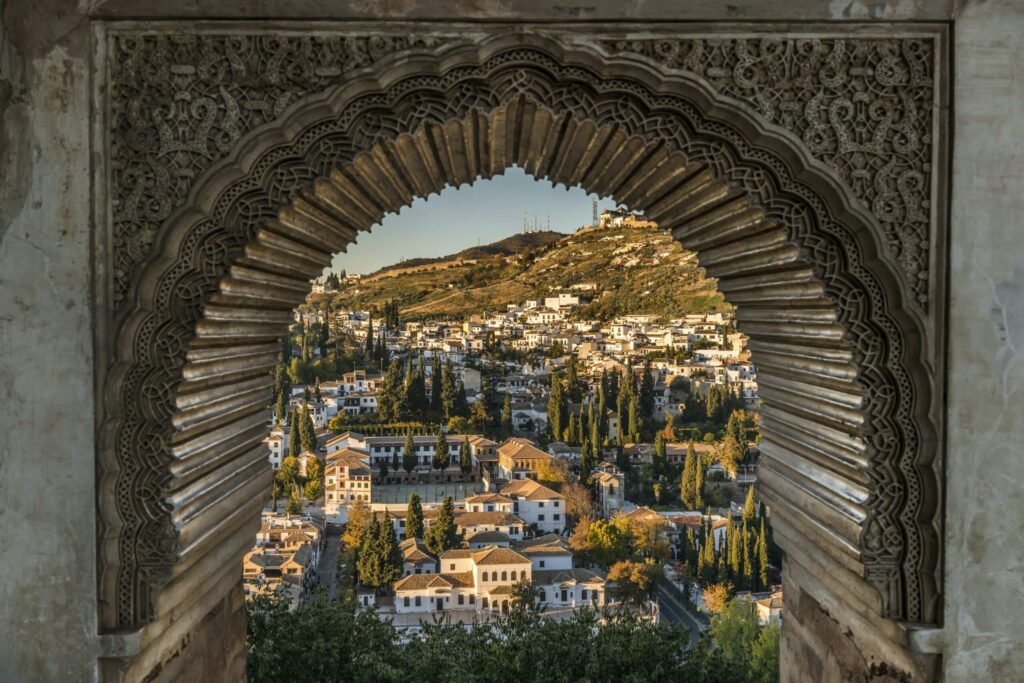
Andalusia Must-see Attractions
In this Andalusia Must-See Attractions, we will show you some of the central Andalusian pearls and why you should visit this splendid Southern Spanish region
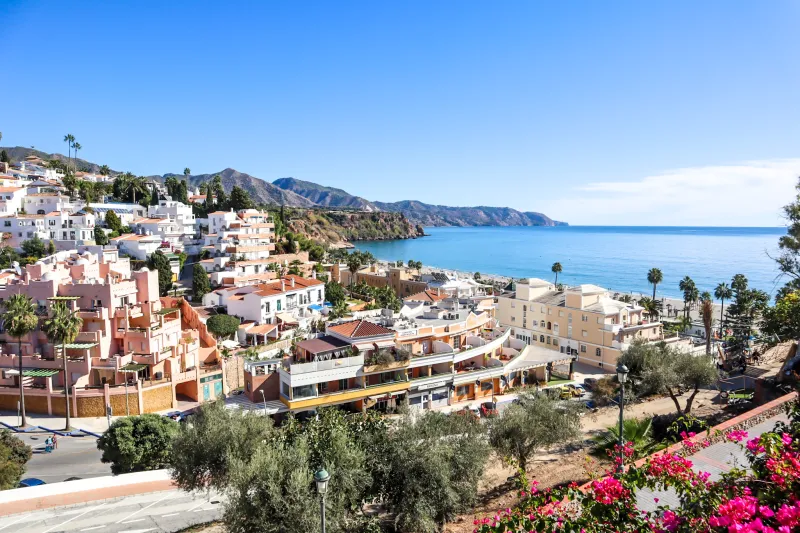
Visit Nerja in Andlasuia
Nerja is a trendy resort town on Costa Del Sol in Andalusia. Therefore, the Visit Nerja article will show why this village is so popular,

Short Madrid travel guide
Madrid is a fascinating place with an energy that carries a straightforward message: this city knows how to live.If you are here, you will probably
Photo credits:
Feature picture credits: ©expansion.com

